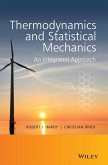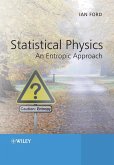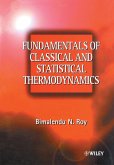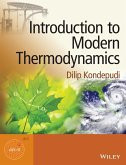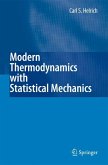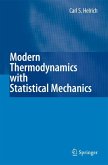- Broschiertes Buch
- Merkliste
- Auf die Merkliste
- Bewerten Bewerten
- Teilen
- Produkt teilen
- Produkterinnerung
- Produkterinnerung
This textbook brings together the fundamentals of the macroscopic and microscopic aspects of thermal physics by presenting thermodynamics and statistical mechanics as complementary theories based on small numbers of postulates. The book is designed to give the instructor flexibility in structuring courses for advanced undergraduates and/or beginning graduate students and is written on the principle that a good text should also be a good reference.
The presentation of thermodynamics follows the logic of Clausius and Kelvin while relating the concepts involved to familiar phenomena and the…mehr
Andere Kunden interessierten sich auch für
![Thermodynamics and Statistical Thermodynamics and Statistical]() Robert J. HardyThermodynamics and Statistical133,99 €
Robert J. HardyThermodynamics and Statistical133,99 €![Statistical Physics Statistical Physics]() Ian FordStatistical Physics52,99 €
Ian FordStatistical Physics52,99 €![Fundamentals of Classical and Statistical Thermodynamics Fundamentals of Classical and Statistical Thermodynamics]() Bimalendu Narayan RoyFundamentals of Classical and Statistical Thermodynamics94,99 €
Bimalendu Narayan RoyFundamentals of Classical and Statistical Thermodynamics94,99 €![Introduction to Modern Thermodynamics Introduction to Modern Thermodynamics]() Dilip KondepudiIntroduction to Modern Thermodynamics66,99 €
Dilip KondepudiIntroduction to Modern Thermodynamics66,99 €![Rotating Thermal Flows in Natural and Industrial Processes Rotating Thermal Flows in Natural and Industrial Processes]() Marcello LappaRotating Thermal Flows in Natural and Industrial Processes176,99 €
Marcello LappaRotating Thermal Flows in Natural and Industrial Processes176,99 €![Modern Thermodynamics with Statistical Mechanics Modern Thermodynamics with Statistical Mechanics]() Carl S. HelrichModern Thermodynamics with Statistical Mechanics38,99 €
Carl S. HelrichModern Thermodynamics with Statistical Mechanics38,99 €![Modern Thermodynamics with Statistical Mechanics Modern Thermodynamics with Statistical Mechanics]() Carl S. HelrichModern Thermodynamics with Statistical Mechanics38,99 €
Carl S. HelrichModern Thermodynamics with Statistical Mechanics38,99 €-
-
-
This textbook brings together the fundamentals of the macroscopic and microscopic aspects of thermal physics by presenting thermodynamics and statistical mechanics as complementary theories based on small numbers of postulates. The book is designed to give the instructor flexibility in structuring courses for advanced undergraduates and/or beginning graduate students and is written on the principle that a good text should also be a good reference.
The presentation of thermodynamics follows the logic of Clausius and Kelvin while relating the concepts involved to familiar phenomena and the modern student s knowledge of the atomic nature of matter. Another unique aspect of the book is the treatment of the mathematics involved. The essential mathematical concepts are briefly reviewed before using them, and the similarity of the mathematics to that employed in other fields of physics is emphasized.
The text gives in depth treatments of low density gases, harmonic solids, magnetic and dielectric materials, phase transitions, and the concept of entropy. The microcanonical, canonical, and grand canonical ensembles of statistical mechanics are derived and used as the starting point for the analysis of fluctuations, blackbody radiation, the Maxwell distribution, Fermi-Dirac statistics, Bose-Einstein condensation, and the statistical basis of computer simulations.
Supplementary material including PowerPoint slides and detailed worked solutions can be downloaded online at http://booksupport.wiley.com
Hinweis: Dieser Artikel kann nur an eine deutsche Lieferadresse ausgeliefert werden.
The presentation of thermodynamics follows the logic of Clausius and Kelvin while relating the concepts involved to familiar phenomena and the modern student s knowledge of the atomic nature of matter. Another unique aspect of the book is the treatment of the mathematics involved. The essential mathematical concepts are briefly reviewed before using them, and the similarity of the mathematics to that employed in other fields of physics is emphasized.
The text gives in depth treatments of low density gases, harmonic solids, magnetic and dielectric materials, phase transitions, and the concept of entropy. The microcanonical, canonical, and grand canonical ensembles of statistical mechanics are derived and used as the starting point for the analysis of fluctuations, blackbody radiation, the Maxwell distribution, Fermi-Dirac statistics, Bose-Einstein condensation, and the statistical basis of computer simulations.
Supplementary material including PowerPoint slides and detailed worked solutions can be downloaded online at http://booksupport.wiley.com
Hinweis: Dieser Artikel kann nur an eine deutsche Lieferadresse ausgeliefert werden.
Produktdetails
- Produktdetails
- Verlag: Wiley & Sons
- Artikelnr. des Verlages: 1W118501000
- 1. Auflage
- Seitenzahl: 534
- Erscheinungstermin: 30. Mai 2014
- Englisch
- Abmessung: 244mm x 170mm x 29mm
- Gewicht: 911g
- ISBN-13: 9781118501009
- ISBN-10: 1118501004
- Artikelnr.: 38107204
- Herstellerkennzeichnung
- Books on Demand GmbH
- In de Tarpen 42
- 22848 Norderstedt
- info@bod.de
- 040 53433511
- Verlag: Wiley & Sons
- Artikelnr. des Verlages: 1W118501000
- 1. Auflage
- Seitenzahl: 534
- Erscheinungstermin: 30. Mai 2014
- Englisch
- Abmessung: 244mm x 170mm x 29mm
- Gewicht: 911g
- ISBN-13: 9781118501009
- ISBN-10: 1118501004
- Artikelnr.: 38107204
- Herstellerkennzeichnung
- Books on Demand GmbH
- In de Tarpen 42
- 22848 Norderstedt
- info@bod.de
- 040 53433511
Robert J. Hardy and Christian Binek Department of Physics, University of Nebraska-Lincoln, USA
Preface xiii Part I Elements of Thermal Physics 1 1. Fundamentals 3 1.1 PVT
Systems 3 1.2 Equilibrium States 6 1.3 Processes and Heat 10 1.4
Temperature 12 1.5 Size Dependence 13 1.6 Heat Capacity and Specific Heat
14 Problems 17 2. First Law of Thermodynamics 19 2.1 Work 19 2.2 Heat 21
2.3 The First Law 21 2.4 Applications 22 Problems 26 3. Properties and
Partial Derivatives 27 3.1 Conventions 27 3.2 Equilibrium Properties 28 3.3
Relationships between Properties 34 3.4 Series Expansions 40 3.5 Summary 41
Problems 42 4. Processes in Gases 45 4.1 Ideal Gases 45 4.2 Temperature
Change with Elevation 48 4.3 Cyclic Processes 50 4.4 Heat Engines 52
Problems 58 5. Phase Transitions 61 5.1 Solids, Liquids, and Gases 61 5.2
Latent Heats 65 5.3 Van der Waals Model 67 5.4 Classification of Phase
Transitions 70 Problems 72 6. Reversible and Irreversible Processes 75 6.1
Idealization and Reversibility 75 6.2 Nonequilibrium Processes and
Irreversibility 76 6.3 Electrical Systems 79 6.4 Heat Conduction 82
Problems 86 Part II Foundations of Thermodynamics 89 7. Second Law of
Thermodynamics 91 7.1 Energy, Heat, and Reversibility 91 7.2 Cyclic
Processes 93 7.3 Second Law of Thermodynamics 95 7.4 Carnot Cycles 98 7.5
Absolute Temperature 100 7.6 Applications 103 Problems 107 8. Temperature
Scales and Absolute Zero 109 8.1 Temperature Scales 109 8.2 Uniform Scales
and Absolute Zero 111 8.3 Other Temperature Scales 114 Problems 115 9.
State Space and Differentials 117 9.1 Spaces 117 9.2 Differentials 121 9.3
Exact Versus Inexact Differentials 123 9.4 Integrating Differentials 127
9.5 Differentials in Thermodynamics 129 9.6 Discussion and Summary 134
Problems 136 10. Entropy 139 10.1 Definition of Entropy 139 10.2 Clausius'
Theorem 142 10.3 Entropy Principle 145 10.4 Entropy and Irreversibility 148
10.5 Useful Energy 151 10.6 The Third Law 155 10.7 Unattainability of
Absolute Zero 156 Problems 158 Appendix 10.A. Entropy Statement of the
Second Law 158 11. Consequences of Existence of Entropy 165 11.1
Differentials of Entropy and Energy 165 11.2 Ideal Gases 167 11.3
Relationships Between CV, CP, BT , BS, and alphaV 170 11.4 Clapeyron's
Equation 172 11.5 Maximum Entropy, Equilibrium, and Stability 174 11.6
Mixing 178 Problems 184 12. Thermodynamic Potentials 185 12.1 Internal
Energy 185 12.2 Free Energies 186 12.3 Properties From Potentials 188 12.4
Systems in Contact with a Heat Reservoir 193 12.5 Minimum Free Energy 194
Problems 197 Appendix 12.A. Derivatives of Potentials 197 13. Phase
Transitions and Open Systems 201 13.1 Two-Phase Equilibrium 201 13.2
Chemical Potential 206 13.3 Multi-Component Systems 211 13.4 Gibbs Phase
Rule 214 13.5 Chemical Reactions 215 Problems 217 14. Dielectric and
Magnetic Systems 219 14.1 Dielectrics 219 14.2 Magnetic Materials 224 14.3
Critical Phenomena 229 Problems 233 Part III Statistical Thermodynamics 235
15. Molecular Models 237 15.1 Microscopic Descriptions 237 15.2 Gas
Pressure 238 15.3 Equipartition of Energy 243 15.4 Internal Energy of
Solids 246 15.5 Inactive Degrees of Freedom 247 15.6 Microscopic
Significance of Heat 248 Problems 253 16. Kinetic Theory of Gases 255 16.1
Velocity Distribution 255 16.2 Combinatorics 256 16.3 Method of
Undetermined Multipliers 258 16.4 Maxwell Distribution 260 16.5
Mean-Free-Path 265 Problems 267 Appendix 16.A. Quantum Distributions 267
17. Microscopic Significance of Entropy 273 17.1 Boltzmann Entropy 273 17.2
Ideal Gas 274 17.3 Statistical Interpretation 278 17.4 Thermodynamic
Properties 279 17.5 Boltzmann Factors 284 Problems 286 Appendix 17.A.
Evaluation of I3N 286 Part IV Statistical Mechanics I 289 18. Ensembles 291
18.1 Probabilities and Averages 291 18.2 Two-Level Systems 293 18.3
Information Theory 295 18.4 Equilibrium Ensembles 298 18.5 Canonical
Thermodynamics 302 18.6 Composite Systems 305 Problems 308 Appendix 18.A.
Uniqueness Theorem 308 19. Partition Function 311 19.1 Hamiltonians and
Phase Space 311 19.2 Model Hamiltonians 312 19.3 Classical Canonical
Ensemble 316 19.4 Thermodynamic Properties and Averages 318 19.5 Ideal
Gases 322 19.6 Harmonic Solids 326 Problems 328 20. Quantum Systems 331
20.1 Energy Eigenstates 331 20.2 Quantum Canonical Ensemble 333 20.3 Ideal
Gases 334 20.4 Einstein Model 337 20.5 Classical Approximation 341 Problems
344 Appendix 20.A. Ideal Gas Eigenstates 344 21. Independent Particles and
Paramagnetism 349 21.1 Averages 349 21.2 Statistical Independence 351 21.3
Classical Systems 353 21.4 Paramagnetism 357 21.5 Spin Systems 360 21.6
Classical Dipoles 365 Problems 367 Appendix 21.A. Negative Temperature 367
22. Fluctuations and Energy Distributions 371 22.1 Standard Deviation 371
22.2 Energy Fluctuations 375 22.3 Gibbs Paradox 376 22.4 Microcanonical
Ensemble 380 22.5 Comparison of Ensembles 386 Problems 391 23.
Generalizations and Diatomic Gases 393 23.1 Generalized Coordinates 393
23.2 Diatomic Gases 397 23.3 Quantum Effects 402 23.4 Density Matrices 405
23.5 Canonical Ensemble 408 Problems 410 Appendix 23.A. Classical
Approximation 410 Part V Statistical Mechanics II 415 24. Photons and
Phonons 417 24.1 Plane Wave Eigenstates 417 24.2 Photons 421 24.3 Harmonic
Approximation 425 24.4 Phonons 429 Problems 434 25. Grand Canonical
Ensemble 435 25.1 Thermodynamics of Open Systems 435 25.2 Grand Canonical
Ensemble 437 25.3 Properties and Fluctuations 438 25.4 Ideal Gases 441
Problems 443 26. Fermions and Bosons 445 26.1 Identical Particles 445 26.2
Exchange Symmetry 447 26.3 Fermi-Dirac and Bose-Einstein Statistics 452
Problems 456 Appendix 26.A. Fermions in the Canonical Ensemble 457 27.
Fermi and Bose Gases 461 27.1 Ideal Gases 461 27.2 Fermi Gases 465 27.3 Low
Temperature Heat Capacity 466 27.4 Bose Gases 469 Problems 472 28.
Interacting Systems 475 28.1 Ising Model 475 28.2 Nonideal Gases 481
Problems 487 29. Computer Simulations 489 29.1 Averages 489 29.2 Virial
Formula for Pressure 490 29.3 Simulation Algorithms 496 A. Mathematical
Relations, Constants, and Properties 501 A.1 Partial Derivatives 501 A.2
Integrals and Series 501 A.3 Taylor Series 502 A.4 Hyperbolic Functions 502
A.5 Fundamental Constants 503 A.6 Conversion Factors 503 A.7 Useful
Formulas 503 A.8 Properties of Water 504 A.9 Properties of Materials 504
Answers to Problems 505 Index 509
Systems 3 1.2 Equilibrium States 6 1.3 Processes and Heat 10 1.4
Temperature 12 1.5 Size Dependence 13 1.6 Heat Capacity and Specific Heat
14 Problems 17 2. First Law of Thermodynamics 19 2.1 Work 19 2.2 Heat 21
2.3 The First Law 21 2.4 Applications 22 Problems 26 3. Properties and
Partial Derivatives 27 3.1 Conventions 27 3.2 Equilibrium Properties 28 3.3
Relationships between Properties 34 3.4 Series Expansions 40 3.5 Summary 41
Problems 42 4. Processes in Gases 45 4.1 Ideal Gases 45 4.2 Temperature
Change with Elevation 48 4.3 Cyclic Processes 50 4.4 Heat Engines 52
Problems 58 5. Phase Transitions 61 5.1 Solids, Liquids, and Gases 61 5.2
Latent Heats 65 5.3 Van der Waals Model 67 5.4 Classification of Phase
Transitions 70 Problems 72 6. Reversible and Irreversible Processes 75 6.1
Idealization and Reversibility 75 6.2 Nonequilibrium Processes and
Irreversibility 76 6.3 Electrical Systems 79 6.4 Heat Conduction 82
Problems 86 Part II Foundations of Thermodynamics 89 7. Second Law of
Thermodynamics 91 7.1 Energy, Heat, and Reversibility 91 7.2 Cyclic
Processes 93 7.3 Second Law of Thermodynamics 95 7.4 Carnot Cycles 98 7.5
Absolute Temperature 100 7.6 Applications 103 Problems 107 8. Temperature
Scales and Absolute Zero 109 8.1 Temperature Scales 109 8.2 Uniform Scales
and Absolute Zero 111 8.3 Other Temperature Scales 114 Problems 115 9.
State Space and Differentials 117 9.1 Spaces 117 9.2 Differentials 121 9.3
Exact Versus Inexact Differentials 123 9.4 Integrating Differentials 127
9.5 Differentials in Thermodynamics 129 9.6 Discussion and Summary 134
Problems 136 10. Entropy 139 10.1 Definition of Entropy 139 10.2 Clausius'
Theorem 142 10.3 Entropy Principle 145 10.4 Entropy and Irreversibility 148
10.5 Useful Energy 151 10.6 The Third Law 155 10.7 Unattainability of
Absolute Zero 156 Problems 158 Appendix 10.A. Entropy Statement of the
Second Law 158 11. Consequences of Existence of Entropy 165 11.1
Differentials of Entropy and Energy 165 11.2 Ideal Gases 167 11.3
Relationships Between CV, CP, BT , BS, and alphaV 170 11.4 Clapeyron's
Equation 172 11.5 Maximum Entropy, Equilibrium, and Stability 174 11.6
Mixing 178 Problems 184 12. Thermodynamic Potentials 185 12.1 Internal
Energy 185 12.2 Free Energies 186 12.3 Properties From Potentials 188 12.4
Systems in Contact with a Heat Reservoir 193 12.5 Minimum Free Energy 194
Problems 197 Appendix 12.A. Derivatives of Potentials 197 13. Phase
Transitions and Open Systems 201 13.1 Two-Phase Equilibrium 201 13.2
Chemical Potential 206 13.3 Multi-Component Systems 211 13.4 Gibbs Phase
Rule 214 13.5 Chemical Reactions 215 Problems 217 14. Dielectric and
Magnetic Systems 219 14.1 Dielectrics 219 14.2 Magnetic Materials 224 14.3
Critical Phenomena 229 Problems 233 Part III Statistical Thermodynamics 235
15. Molecular Models 237 15.1 Microscopic Descriptions 237 15.2 Gas
Pressure 238 15.3 Equipartition of Energy 243 15.4 Internal Energy of
Solids 246 15.5 Inactive Degrees of Freedom 247 15.6 Microscopic
Significance of Heat 248 Problems 253 16. Kinetic Theory of Gases 255 16.1
Velocity Distribution 255 16.2 Combinatorics 256 16.3 Method of
Undetermined Multipliers 258 16.4 Maxwell Distribution 260 16.5
Mean-Free-Path 265 Problems 267 Appendix 16.A. Quantum Distributions 267
17. Microscopic Significance of Entropy 273 17.1 Boltzmann Entropy 273 17.2
Ideal Gas 274 17.3 Statistical Interpretation 278 17.4 Thermodynamic
Properties 279 17.5 Boltzmann Factors 284 Problems 286 Appendix 17.A.
Evaluation of I3N 286 Part IV Statistical Mechanics I 289 18. Ensembles 291
18.1 Probabilities and Averages 291 18.2 Two-Level Systems 293 18.3
Information Theory 295 18.4 Equilibrium Ensembles 298 18.5 Canonical
Thermodynamics 302 18.6 Composite Systems 305 Problems 308 Appendix 18.A.
Uniqueness Theorem 308 19. Partition Function 311 19.1 Hamiltonians and
Phase Space 311 19.2 Model Hamiltonians 312 19.3 Classical Canonical
Ensemble 316 19.4 Thermodynamic Properties and Averages 318 19.5 Ideal
Gases 322 19.6 Harmonic Solids 326 Problems 328 20. Quantum Systems 331
20.1 Energy Eigenstates 331 20.2 Quantum Canonical Ensemble 333 20.3 Ideal
Gases 334 20.4 Einstein Model 337 20.5 Classical Approximation 341 Problems
344 Appendix 20.A. Ideal Gas Eigenstates 344 21. Independent Particles and
Paramagnetism 349 21.1 Averages 349 21.2 Statistical Independence 351 21.3
Classical Systems 353 21.4 Paramagnetism 357 21.5 Spin Systems 360 21.6
Classical Dipoles 365 Problems 367 Appendix 21.A. Negative Temperature 367
22. Fluctuations and Energy Distributions 371 22.1 Standard Deviation 371
22.2 Energy Fluctuations 375 22.3 Gibbs Paradox 376 22.4 Microcanonical
Ensemble 380 22.5 Comparison of Ensembles 386 Problems 391 23.
Generalizations and Diatomic Gases 393 23.1 Generalized Coordinates 393
23.2 Diatomic Gases 397 23.3 Quantum Effects 402 23.4 Density Matrices 405
23.5 Canonical Ensemble 408 Problems 410 Appendix 23.A. Classical
Approximation 410 Part V Statistical Mechanics II 415 24. Photons and
Phonons 417 24.1 Plane Wave Eigenstates 417 24.2 Photons 421 24.3 Harmonic
Approximation 425 24.4 Phonons 429 Problems 434 25. Grand Canonical
Ensemble 435 25.1 Thermodynamics of Open Systems 435 25.2 Grand Canonical
Ensemble 437 25.3 Properties and Fluctuations 438 25.4 Ideal Gases 441
Problems 443 26. Fermions and Bosons 445 26.1 Identical Particles 445 26.2
Exchange Symmetry 447 26.3 Fermi-Dirac and Bose-Einstein Statistics 452
Problems 456 Appendix 26.A. Fermions in the Canonical Ensemble 457 27.
Fermi and Bose Gases 461 27.1 Ideal Gases 461 27.2 Fermi Gases 465 27.3 Low
Temperature Heat Capacity 466 27.4 Bose Gases 469 Problems 472 28.
Interacting Systems 475 28.1 Ising Model 475 28.2 Nonideal Gases 481
Problems 487 29. Computer Simulations 489 29.1 Averages 489 29.2 Virial
Formula for Pressure 490 29.3 Simulation Algorithms 496 A. Mathematical
Relations, Constants, and Properties 501 A.1 Partial Derivatives 501 A.2
Integrals and Series 501 A.3 Taylor Series 502 A.4 Hyperbolic Functions 502
A.5 Fundamental Constants 503 A.6 Conversion Factors 503 A.7 Useful
Formulas 503 A.8 Properties of Water 504 A.9 Properties of Materials 504
Answers to Problems 505 Index 509
Preface xiii Part I Elements of Thermal Physics 1 1. Fundamentals 3 1.1 PVT
Systems 3 1.2 Equilibrium States 6 1.3 Processes and Heat 10 1.4
Temperature 12 1.5 Size Dependence 13 1.6 Heat Capacity and Specific Heat
14 Problems 17 2. First Law of Thermodynamics 19 2.1 Work 19 2.2 Heat 21
2.3 The First Law 21 2.4 Applications 22 Problems 26 3. Properties and
Partial Derivatives 27 3.1 Conventions 27 3.2 Equilibrium Properties 28 3.3
Relationships between Properties 34 3.4 Series Expansions 40 3.5 Summary 41
Problems 42 4. Processes in Gases 45 4.1 Ideal Gases 45 4.2 Temperature
Change with Elevation 48 4.3 Cyclic Processes 50 4.4 Heat Engines 52
Problems 58 5. Phase Transitions 61 5.1 Solids, Liquids, and Gases 61 5.2
Latent Heats 65 5.3 Van der Waals Model 67 5.4 Classification of Phase
Transitions 70 Problems 72 6. Reversible and Irreversible Processes 75 6.1
Idealization and Reversibility 75 6.2 Nonequilibrium Processes and
Irreversibility 76 6.3 Electrical Systems 79 6.4 Heat Conduction 82
Problems 86 Part II Foundations of Thermodynamics 89 7. Second Law of
Thermodynamics 91 7.1 Energy, Heat, and Reversibility 91 7.2 Cyclic
Processes 93 7.3 Second Law of Thermodynamics 95 7.4 Carnot Cycles 98 7.5
Absolute Temperature 100 7.6 Applications 103 Problems 107 8. Temperature
Scales and Absolute Zero 109 8.1 Temperature Scales 109 8.2 Uniform Scales
and Absolute Zero 111 8.3 Other Temperature Scales 114 Problems 115 9.
State Space and Differentials 117 9.1 Spaces 117 9.2 Differentials 121 9.3
Exact Versus Inexact Differentials 123 9.4 Integrating Differentials 127
9.5 Differentials in Thermodynamics 129 9.6 Discussion and Summary 134
Problems 136 10. Entropy 139 10.1 Definition of Entropy 139 10.2 Clausius'
Theorem 142 10.3 Entropy Principle 145 10.4 Entropy and Irreversibility 148
10.5 Useful Energy 151 10.6 The Third Law 155 10.7 Unattainability of
Absolute Zero 156 Problems 158 Appendix 10.A. Entropy Statement of the
Second Law 158 11. Consequences of Existence of Entropy 165 11.1
Differentials of Entropy and Energy 165 11.2 Ideal Gases 167 11.3
Relationships Between CV, CP, BT , BS, and alphaV 170 11.4 Clapeyron's
Equation 172 11.5 Maximum Entropy, Equilibrium, and Stability 174 11.6
Mixing 178 Problems 184 12. Thermodynamic Potentials 185 12.1 Internal
Energy 185 12.2 Free Energies 186 12.3 Properties From Potentials 188 12.4
Systems in Contact with a Heat Reservoir 193 12.5 Minimum Free Energy 194
Problems 197 Appendix 12.A. Derivatives of Potentials 197 13. Phase
Transitions and Open Systems 201 13.1 Two-Phase Equilibrium 201 13.2
Chemical Potential 206 13.3 Multi-Component Systems 211 13.4 Gibbs Phase
Rule 214 13.5 Chemical Reactions 215 Problems 217 14. Dielectric and
Magnetic Systems 219 14.1 Dielectrics 219 14.2 Magnetic Materials 224 14.3
Critical Phenomena 229 Problems 233 Part III Statistical Thermodynamics 235
15. Molecular Models 237 15.1 Microscopic Descriptions 237 15.2 Gas
Pressure 238 15.3 Equipartition of Energy 243 15.4 Internal Energy of
Solids 246 15.5 Inactive Degrees of Freedom 247 15.6 Microscopic
Significance of Heat 248 Problems 253 16. Kinetic Theory of Gases 255 16.1
Velocity Distribution 255 16.2 Combinatorics 256 16.3 Method of
Undetermined Multipliers 258 16.4 Maxwell Distribution 260 16.5
Mean-Free-Path 265 Problems 267 Appendix 16.A. Quantum Distributions 267
17. Microscopic Significance of Entropy 273 17.1 Boltzmann Entropy 273 17.2
Ideal Gas 274 17.3 Statistical Interpretation 278 17.4 Thermodynamic
Properties 279 17.5 Boltzmann Factors 284 Problems 286 Appendix 17.A.
Evaluation of I3N 286 Part IV Statistical Mechanics I 289 18. Ensembles 291
18.1 Probabilities and Averages 291 18.2 Two-Level Systems 293 18.3
Information Theory 295 18.4 Equilibrium Ensembles 298 18.5 Canonical
Thermodynamics 302 18.6 Composite Systems 305 Problems 308 Appendix 18.A.
Uniqueness Theorem 308 19. Partition Function 311 19.1 Hamiltonians and
Phase Space 311 19.2 Model Hamiltonians 312 19.3 Classical Canonical
Ensemble 316 19.4 Thermodynamic Properties and Averages 318 19.5 Ideal
Gases 322 19.6 Harmonic Solids 326 Problems 328 20. Quantum Systems 331
20.1 Energy Eigenstates 331 20.2 Quantum Canonical Ensemble 333 20.3 Ideal
Gases 334 20.4 Einstein Model 337 20.5 Classical Approximation 341 Problems
344 Appendix 20.A. Ideal Gas Eigenstates 344 21. Independent Particles and
Paramagnetism 349 21.1 Averages 349 21.2 Statistical Independence 351 21.3
Classical Systems 353 21.4 Paramagnetism 357 21.5 Spin Systems 360 21.6
Classical Dipoles 365 Problems 367 Appendix 21.A. Negative Temperature 367
22. Fluctuations and Energy Distributions 371 22.1 Standard Deviation 371
22.2 Energy Fluctuations 375 22.3 Gibbs Paradox 376 22.4 Microcanonical
Ensemble 380 22.5 Comparison of Ensembles 386 Problems 391 23.
Generalizations and Diatomic Gases 393 23.1 Generalized Coordinates 393
23.2 Diatomic Gases 397 23.3 Quantum Effects 402 23.4 Density Matrices 405
23.5 Canonical Ensemble 408 Problems 410 Appendix 23.A. Classical
Approximation 410 Part V Statistical Mechanics II 415 24. Photons and
Phonons 417 24.1 Plane Wave Eigenstates 417 24.2 Photons 421 24.3 Harmonic
Approximation 425 24.4 Phonons 429 Problems 434 25. Grand Canonical
Ensemble 435 25.1 Thermodynamics of Open Systems 435 25.2 Grand Canonical
Ensemble 437 25.3 Properties and Fluctuations 438 25.4 Ideal Gases 441
Problems 443 26. Fermions and Bosons 445 26.1 Identical Particles 445 26.2
Exchange Symmetry 447 26.3 Fermi-Dirac and Bose-Einstein Statistics 452
Problems 456 Appendix 26.A. Fermions in the Canonical Ensemble 457 27.
Fermi and Bose Gases 461 27.1 Ideal Gases 461 27.2 Fermi Gases 465 27.3 Low
Temperature Heat Capacity 466 27.4 Bose Gases 469 Problems 472 28.
Interacting Systems 475 28.1 Ising Model 475 28.2 Nonideal Gases 481
Problems 487 29. Computer Simulations 489 29.1 Averages 489 29.2 Virial
Formula for Pressure 490 29.3 Simulation Algorithms 496 A. Mathematical
Relations, Constants, and Properties 501 A.1 Partial Derivatives 501 A.2
Integrals and Series 501 A.3 Taylor Series 502 A.4 Hyperbolic Functions 502
A.5 Fundamental Constants 503 A.6 Conversion Factors 503 A.7 Useful
Formulas 503 A.8 Properties of Water 504 A.9 Properties of Materials 504
Answers to Problems 505 Index 509
Systems 3 1.2 Equilibrium States 6 1.3 Processes and Heat 10 1.4
Temperature 12 1.5 Size Dependence 13 1.6 Heat Capacity and Specific Heat
14 Problems 17 2. First Law of Thermodynamics 19 2.1 Work 19 2.2 Heat 21
2.3 The First Law 21 2.4 Applications 22 Problems 26 3. Properties and
Partial Derivatives 27 3.1 Conventions 27 3.2 Equilibrium Properties 28 3.3
Relationships between Properties 34 3.4 Series Expansions 40 3.5 Summary 41
Problems 42 4. Processes in Gases 45 4.1 Ideal Gases 45 4.2 Temperature
Change with Elevation 48 4.3 Cyclic Processes 50 4.4 Heat Engines 52
Problems 58 5. Phase Transitions 61 5.1 Solids, Liquids, and Gases 61 5.2
Latent Heats 65 5.3 Van der Waals Model 67 5.4 Classification of Phase
Transitions 70 Problems 72 6. Reversible and Irreversible Processes 75 6.1
Idealization and Reversibility 75 6.2 Nonequilibrium Processes and
Irreversibility 76 6.3 Electrical Systems 79 6.4 Heat Conduction 82
Problems 86 Part II Foundations of Thermodynamics 89 7. Second Law of
Thermodynamics 91 7.1 Energy, Heat, and Reversibility 91 7.2 Cyclic
Processes 93 7.3 Second Law of Thermodynamics 95 7.4 Carnot Cycles 98 7.5
Absolute Temperature 100 7.6 Applications 103 Problems 107 8. Temperature
Scales and Absolute Zero 109 8.1 Temperature Scales 109 8.2 Uniform Scales
and Absolute Zero 111 8.3 Other Temperature Scales 114 Problems 115 9.
State Space and Differentials 117 9.1 Spaces 117 9.2 Differentials 121 9.3
Exact Versus Inexact Differentials 123 9.4 Integrating Differentials 127
9.5 Differentials in Thermodynamics 129 9.6 Discussion and Summary 134
Problems 136 10. Entropy 139 10.1 Definition of Entropy 139 10.2 Clausius'
Theorem 142 10.3 Entropy Principle 145 10.4 Entropy and Irreversibility 148
10.5 Useful Energy 151 10.6 The Third Law 155 10.7 Unattainability of
Absolute Zero 156 Problems 158 Appendix 10.A. Entropy Statement of the
Second Law 158 11. Consequences of Existence of Entropy 165 11.1
Differentials of Entropy and Energy 165 11.2 Ideal Gases 167 11.3
Relationships Between CV, CP, BT , BS, and alphaV 170 11.4 Clapeyron's
Equation 172 11.5 Maximum Entropy, Equilibrium, and Stability 174 11.6
Mixing 178 Problems 184 12. Thermodynamic Potentials 185 12.1 Internal
Energy 185 12.2 Free Energies 186 12.3 Properties From Potentials 188 12.4
Systems in Contact with a Heat Reservoir 193 12.5 Minimum Free Energy 194
Problems 197 Appendix 12.A. Derivatives of Potentials 197 13. Phase
Transitions and Open Systems 201 13.1 Two-Phase Equilibrium 201 13.2
Chemical Potential 206 13.3 Multi-Component Systems 211 13.4 Gibbs Phase
Rule 214 13.5 Chemical Reactions 215 Problems 217 14. Dielectric and
Magnetic Systems 219 14.1 Dielectrics 219 14.2 Magnetic Materials 224 14.3
Critical Phenomena 229 Problems 233 Part III Statistical Thermodynamics 235
15. Molecular Models 237 15.1 Microscopic Descriptions 237 15.2 Gas
Pressure 238 15.3 Equipartition of Energy 243 15.4 Internal Energy of
Solids 246 15.5 Inactive Degrees of Freedom 247 15.6 Microscopic
Significance of Heat 248 Problems 253 16. Kinetic Theory of Gases 255 16.1
Velocity Distribution 255 16.2 Combinatorics 256 16.3 Method of
Undetermined Multipliers 258 16.4 Maxwell Distribution 260 16.5
Mean-Free-Path 265 Problems 267 Appendix 16.A. Quantum Distributions 267
17. Microscopic Significance of Entropy 273 17.1 Boltzmann Entropy 273 17.2
Ideal Gas 274 17.3 Statistical Interpretation 278 17.4 Thermodynamic
Properties 279 17.5 Boltzmann Factors 284 Problems 286 Appendix 17.A.
Evaluation of I3N 286 Part IV Statistical Mechanics I 289 18. Ensembles 291
18.1 Probabilities and Averages 291 18.2 Two-Level Systems 293 18.3
Information Theory 295 18.4 Equilibrium Ensembles 298 18.5 Canonical
Thermodynamics 302 18.6 Composite Systems 305 Problems 308 Appendix 18.A.
Uniqueness Theorem 308 19. Partition Function 311 19.1 Hamiltonians and
Phase Space 311 19.2 Model Hamiltonians 312 19.3 Classical Canonical
Ensemble 316 19.4 Thermodynamic Properties and Averages 318 19.5 Ideal
Gases 322 19.6 Harmonic Solids 326 Problems 328 20. Quantum Systems 331
20.1 Energy Eigenstates 331 20.2 Quantum Canonical Ensemble 333 20.3 Ideal
Gases 334 20.4 Einstein Model 337 20.5 Classical Approximation 341 Problems
344 Appendix 20.A. Ideal Gas Eigenstates 344 21. Independent Particles and
Paramagnetism 349 21.1 Averages 349 21.2 Statistical Independence 351 21.3
Classical Systems 353 21.4 Paramagnetism 357 21.5 Spin Systems 360 21.6
Classical Dipoles 365 Problems 367 Appendix 21.A. Negative Temperature 367
22. Fluctuations and Energy Distributions 371 22.1 Standard Deviation 371
22.2 Energy Fluctuations 375 22.3 Gibbs Paradox 376 22.4 Microcanonical
Ensemble 380 22.5 Comparison of Ensembles 386 Problems 391 23.
Generalizations and Diatomic Gases 393 23.1 Generalized Coordinates 393
23.2 Diatomic Gases 397 23.3 Quantum Effects 402 23.4 Density Matrices 405
23.5 Canonical Ensemble 408 Problems 410 Appendix 23.A. Classical
Approximation 410 Part V Statistical Mechanics II 415 24. Photons and
Phonons 417 24.1 Plane Wave Eigenstates 417 24.2 Photons 421 24.3 Harmonic
Approximation 425 24.4 Phonons 429 Problems 434 25. Grand Canonical
Ensemble 435 25.1 Thermodynamics of Open Systems 435 25.2 Grand Canonical
Ensemble 437 25.3 Properties and Fluctuations 438 25.4 Ideal Gases 441
Problems 443 26. Fermions and Bosons 445 26.1 Identical Particles 445 26.2
Exchange Symmetry 447 26.3 Fermi-Dirac and Bose-Einstein Statistics 452
Problems 456 Appendix 26.A. Fermions in the Canonical Ensemble 457 27.
Fermi and Bose Gases 461 27.1 Ideal Gases 461 27.2 Fermi Gases 465 27.3 Low
Temperature Heat Capacity 466 27.4 Bose Gases 469 Problems 472 28.
Interacting Systems 475 28.1 Ising Model 475 28.2 Nonideal Gases 481
Problems 487 29. Computer Simulations 489 29.1 Averages 489 29.2 Virial
Formula for Pressure 490 29.3 Simulation Algorithms 496 A. Mathematical
Relations, Constants, and Properties 501 A.1 Partial Derivatives 501 A.2
Integrals and Series 501 A.3 Taylor Series 502 A.4 Hyperbolic Functions 502
A.5 Fundamental Constants 503 A.6 Conversion Factors 503 A.7 Useful
Formulas 503 A.8 Properties of Water 504 A.9 Properties of Materials 504
Answers to Problems 505 Index 509


